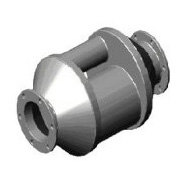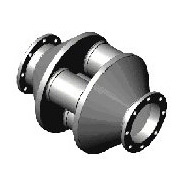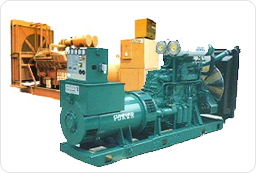Emission Purifiers & Filters
We specialize in producing Direct-through and Wall-flowed honeycomb monoliths, Three Way
Catalyst, Diesel Engines Emission Purifier (DEEP) and Diesel Soot Catalytic Filter (DSCF).
Products are mainly used on generator-set, petrol vehicles, urban buses, and mining machinery
for emission purification.
 |
 |
We aim to provide highly efficient, cost-effective, reliable and stable technologies with perfect after-sale service and prompt and timely delivery. We are also committed to innovation and invention in our technology in order to meet new government regulations in many different countries.
Diesel Exhaust Catalytic Purifiers are available with two different catalyst systems:
Diesel Engine Emission Purifier (DEEP)
...SP-Series diesel three way catalyst
Diesel Soot Catalytic Filter (DSCF)
...SPF-Series diesel particulate trap
Diesel is a petroleum product used as a fuel. As a hydrocarbon mixture, it is obtained in the fractional distillation of crude oil between 250°C and 350°C at atmospheric pressure. Used in diesel engines, this type of internal combustion engine was invented by Rudolf Diesel. Diesel fuel is injected under pressure into the engine cylinder where it mixes with air and where the combustion occurs. Unfortunately, exhaust gases which are discharged from diesel engines contain several constituents that are harmful to human health and to the environment.
These constituents are:
- Carbon Monoxide (CO)
- Hydrocarbons (HC)
- Aldehydes
- Nitrogen Oxides (NOx)
- Sulfur Dioxide (SO2)
- Diesel Particulate Matter (DPM)
Since the development over the past decades, catalytic converter technology has been successfully employed to significantly reduce the harmful exhaust pollutants from gasoline- powered vehicles and diesel engines. We developed the Diesel Exhaust Catalytic Purifiers on a Three-Way Catalyst basis to improve the performance of diesel engine emission purification.
The purpose of catalytic converters is to convert harmful hydrocarbons, carbon monoxide and nitrogen oxides into harmless compounds.
Catalyst is a substance that accelerates the rate of a chemical reaction but remains unconsumed by the reaction. It participates in the chemical reaction but is neither a chemical reactant nor a chemical product. TRUNETTR catalysts enable reactions to occur at lower temperatures because of changes that they induce in the reactants. Actually, catalysts provide an alternative pathway, one with lower activation energy, for a reaction to proceed. Molecules that would not have had the energy to react or that have such low energies that it is likely that they would take a long time to do so are able to react in the presence of a catalyst.
Catalysts inside of our catalytic purifiers are precious metals such as platinum, palladium and rhodium coated on the surface of ceramic honeycomb structures, resulting in a lifetime of more than 10,000 operation hours without regular maintenance or manual regeneration because of the platinum protection layer. Chemical reactions take place, converting the harmful exhaust gases into harmless compounds when exhaust molecules contact the catalysts.
For oxidation and reduction separately, most of our catalytic converters contain two distinct catalysts: the reduction catalyst and the oxidation catalyst. The exhaust flows through reduction catalyst at first, consists of a ceramic honeycomb normally coated with platinum and rhodium. In this section, NOx emissions are converted into oxygen and nitrogen. When the exhaust flow then passes through the oxidation catalyst, consists of a platinum and palladium honeycomb, unburned hydrocarbons and carbon monoxide are oxidized to harmless carbon dioxide and water. The oxygen generated by the reduction catalyst aids further this oxidizing process. A higher conversion performance can be achieved.
It is important to understand that conversion efficiency is a function of not only exhaust temperature but also exhaust composition. More oxygen content at high temperature leads to higher CO and HC oxidation but lower NOx reduction.
Diesel Engine Emission Purifiers (DEEP)
This standard diesel engine emission purifier (DEEP) utilizes ceramic monolith catalyst substrates. The ceramic substrates are made of cordierite with very low thermal expansion coefficient. In comparison with metallic monoliths, our cordierite substrates are much more stable supports for catalyst coated on the monolith surface. Stability of coated catalyst is also an important factor for long lifetime expectation of diesel exhaust purifiers. High cell density structure and large specific surface force exhaust gases into the turbulent flow regime resulting in better contact between gas and catalyst, enhanced mass-transfer conditions, and higher conversion efficiency.
While exhaust gases contact the catalyst atoms deposited onto the monolith surface at a proper temperature, the catalysts reduce nitrogen oxides to nitrogen and oxygen and simultaneously oxidize carbon monoxide, gaseous and liquid hydrocarbons, including those adsorbed on the carbon particles, to carbon dioxide and water. The liquid hydrocarbons are known as the soluble organic fraction (SOF) and make up part of the total particulate matter. Due to insufficient reaction time, the carbon fraction of the PM remains mostly unaffected when flowing directly through the honeycomb monoliths.
DEEP Models
.jpg)
SP Series Models
Model |
Dimensions |
Ref. Power Rating |
Flange |
|
| D (mm) | H (mm) | KW | F (inch) | |
SP103 |
163 |
360 |
Up to 35 |
2.5 |
SP105 |
163 |
400 | Up to 50 |
3 |
SP107 |
163 |
450 | Up to 70 |
3 |
SP110 |
163 |
490 | Up to 100 |
4 |
| SP416 | 305 |
475 | Up to 160 |
4 |
SP420 |
305 |
510 | Up to 200 |
4 |
SP425 |
305 |
540 | Up to 250 |
4 |
SP432 |
305 |
570 | Up to 320 |
6 |
SP440 |
305 |
630 | Up to 400 |
8 |
SP845 |
305 |
685 | Up to 450 |
8 |
SP850 |
305 |
695 | Up to 500 |
8 |
SP1665 |
590 |
770 | Up to 650 |
8 |
SP1890 |
448 |
830 | Up to 900 |
8 |
SP32110 |
590 |
790 | Up to 1100 |
12 |
SP32135 |
590 |
820 | Up to 1350 |
12 |
SP32160 |
590 |
820 | Up to 1600 |
14 |
SP48200 |
590 |
870 | Up to 2000 |
14 |
SP48225 |
590 |
920 | Up to 2250 |
14 |
SP48250 |
590 |
920 | Up to 2500 |
16 |
SP48275 |
590 |
970 | Up to 2750 |
16 |
Diesel Scoot Catalytic Filters (DSCF)
Working in a similar way as SP-Series, the SPF-Series catalysts show a significantly improved hydrocarbon performance at low exhaust temperatures due to the absorption on the HC trapping material. Since the absorption capacity is always limited and the HC traps have to be periodically regenerated by higher exhaust temperatures, this type of catalyst system is effective only at transient engine operation.
The exact emission performance of catalyst depends on the catalyst size, exhaust temperature, and raw exhaust composition. A minimum temperature of about 180°C is required for conversion. Best catalyst performance occurs at temperatures above 250-300°C when the conversion of carbon monoxide and hydrocarbon exceeds 90%. The reduction of nitrogen oxides is negatively affected at higher temperature. Conversion of diesel particulate matter in the catalyst depends on the composition of the particulates and the sulfur content of the fuel. In application of SPF-Series, equipped with porous ceramic particulate trap, achievable particulate matter reductions amount to over 90% in terms of mass. Low sulfur diesel fuel is strongly recommended for best catalyst performance because the formation of sulfate fraction at high temperature reduces finally the performance of particulate matter reduction.
We offer SP- and SPF-Series diesel exhaust purifiers with the equivalent catalyst technologies which are engineered for different applications. SPF-Series catalysts incorporating porous ceramic particulate trap are especially effective to trap and oxidize particulate matter. Therefore, SPF-Series can be widely used to eliminate soot pollution in urban area generated by heavy-duty diesel engines.
DSCF Models
.jpg)
SPF Series Models
Model |
Dimensions |
Ref. Power Rating |
Flange |
|
| D (mm) | H (mm) | KW | F (inch) | |
| SPF14 | 163 |
400 |
Up to 40 |
2.5 |
SPF15 |
163 |
430 | Up to 50 |
3 |
SPF18 |
203 |
490 | Up to 80 |
3 |
SPF120 |
253 |
570 | Up to 200 |
4 |
SPF125 |
253 |
635 | Up to 250 |
4 |
SPF130 |
273 |
645 | Up to 300 |
6 |
SPF140 |
303 |
655 | Up to 400 |
8 |
SPF250 |
640 |
1180 | Up to 550 |
8 |
SPF260 |
695 |
1235 | Up to 600 |
8 |
SPF280 |
740 |
1280 | Up to 800 |
8 |
SPF390 |
690 |
1230 | Up to 900 |
8 |
SPF3100 |
740 |
1240 | Up to 1000 |
12 |
SPF3130 |
800 |
1240 | Up to 1300 |
12 |
SPF4140 |
840 |
1280 | Up to 1400 |
12 |
SPF4160 |
895 |
1330 | Up to 1600 |
12 |
SPF5180 |
920 |
1340 | Up to 1800 |
14 |
SPF6200 |
1020 |
1410 | Up to 2000 |
14 |
SPF5200 |
1000 |
1390 | Up to 2000 |
14 |
SPF7220 |
1210 |
1560 | Up to 2200 |
14 |
SPF8250 |
1250 |
1600 | Up to 2500 |
16 |
SPF Series Models with Safety Bypass
Model |
Dimensions |
Ref. Power Rating |
Flange |
|
| D (mm) | H (mm) | KW | F (inch) | |
| SPF14S | 290 |
810 |
Up to 40 |
2.5 |
SPF15S |
290 |
840 | Up to 50 |
3 |
SPF18S |
330 |
890 | Up to 80 |
3 |
SPF120S |
380 |
910 | Up to 200 |
4 |
SPF125S |
380 |
975 | Up to 250 |
4 |
SPF130S |
400 |
1040 | Up to 300 |
6 |
SPF140S |
450 |
1100 | Up to 400 |
8 |
SPF255S |
690 |
1230 | Up to 550 |
8 |
SPF260S |
740 |
1280 | Up to 600 |
8 |
SPF280S |
800 |
1340 | Up to 800 |
8 |
SPF390S |
900 |
1440 | Up to 900 |
8 |
SPF3100S |
1020 |
1490 | Up to 1000 |
12 |
SPF3130S |
1100 |
1530 | Up to 1300 |
12 |
SPF4140S |
1010 |
1480 | Up to 1400 |
12 |
SPF4160S |
1100 |
1530 | Up to 1600 |
12 |
SPF5180S |
1120 |
1540 | Up to 1800 |
14 |
SPF6200S |
1160 |
1560 | Up to 2000 |
14 |
SPF5200S |
1150 |
1540 | Up to 2000 |
14 |
SPF7220S |
1210 |
1560 | Up to 2200 |
14 |
SPF8250S |
1250 |
1600 | Up to 2500 |
16 |

